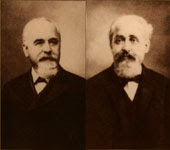TTAB Posts November 2017 Hearing Schedule
The Trademark Trial and Appeal Board (TTAB) has scheduled four (4) oral hearings for the month of November 2017. The hearings will be held in the East Wing of the Madison Building, in Alexandria, Virginia. Briefs and other papers for these cases may be found at TTABVUE via the links provided.

November 14, 2017 -11 AM: Naturex v James McGee, Opposition No. 91214847 [Opposition to registration of NATURX for "Hair shampoos and conditioners; Hair styling fixative in the nature of hair wax; Body lotions; Skin creams; Night cream; Eye cream; Hand creams; Body emulsions; Skin emulsions; Hand emulsions; Body oil; Skin cleansing lotion; Skin cleansing gel; Skin cleansers; Make-up remover; Cleansing Lotions and Gels in the Form of Facial Masks; Lip moisturizer; Bath gel; Bath powder; Bath oil; Bath salts; Body powder; Body splash; Moisturizing Body Mist; Sunless Tanning Lotion; Sunless Tanning Spray; Shaving cream; Tooth paste; Tooth powder; Mouth washes; Non-medicated foot cream; Foot powder,"on the grounds of likelihood of confusion with the registered mark NATUREX for preservatives and colorants used in the manufacturing of cosmetics and aromatics, and essential oils used in manufacturing scented products].
November 14, 2017 - 2 PM: In re Sjovik Limited, Serial No. 86807019 [Section2(d) refusal of HELP! COSMETICS for "Bath salts; Body sprays; Bubble bath; Compacts containing make-up; Cosmetics; Eau de toilette; Face and body glitter; Make-up remover; Make-up sets; Nail enamel; Nail polish; Nail polish remover; Nail varnish; Non-medicated skin care preparations; Perfumes" in class 3, and "On-line retail store services featuring bath salts, body sprays, bubble bath, compacts containing make-up, cosmetics, eau de toilette, face and body glitter, make-up sets, make-up remover, nail enamel, nail polish, nail polish remover, nail varnish, non-medicated skin care preparations, perfumes; Retail store services featuring bath salts, body sprays, bubble bath, compacts containing make-up, cosmetics, eau de toilette, face and body glitter, make-up sets, make-up remover, nail enamel, nail polish, nail polish remover, nail varnish, non-medicated skin care preparations, perfumes" in class 35, in view of the registered marks HELP for hair shampoo and HELP HAIR for hair care preparations].
November 15, 2017 - 11 AM: In re Kipling Apparel Corp., Serial No. 86356569 and 86356608 [Section 2(e)(4) surname refusal of KIPLING for "picture frames" and for "mugs, tumblers, drinking bottles; trays for domestic purposes; coasters not of paper and other than table linen; leather coasters, plastic coasters"].
November 30, 2017 - 11 AM: In re Wal-Mart Stores, Inc., Serial No. 86261962. [Failure-to-function refusal under Section 1, 2, 3, and 45 of the Trademark Act, of the purported mark INVESTING IN AMERICAN JOBS for "promoting public awareness for goods made or assembled by American workers; Retail store services featuring a wide variety of consumer goods; Retail grocery stores; Retail store services featuring a wide variety of consumer goods of others; Retail store services featuring electronics, appliances, indoor and outdoor furniture, home décor, health, beauty and personal care products, household essentials, apparel, home improvement products, grilling products, entertainment recordings, video games, books and publications, musical instruments, office supplies, arts and craft supplies; online retail store services featuring a wide variety of consumer goods; Online retail grocery stores; Online retail store services featuring a wide variety of consumer goods of others; Online retail store services featuring electronics, appliances, indoor and outdoor furniture, grilling products, home improvement products, home décor, health, beauty and personal care products, household essentials, apparel, entertainment recordings, video games, books and publications, musical instruments, office supplies, arts and craft supplies; Retail and on-line grocery store services featuring pickup, in-store pickup and home delivery service; Retail store services featuring convenience store items and gasoline; Convenience store services"].
Read comments and post your comment here.
TTABlog note: Any predictions? See any WYHA?s?
[Do you like Kipling? I don't know. I've never Kippled.]
Text Copyright John L. Welch 2017.






































